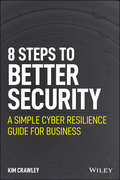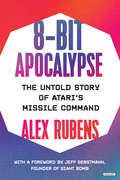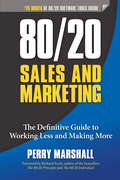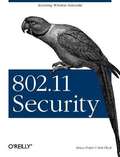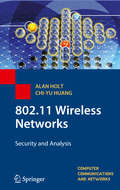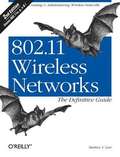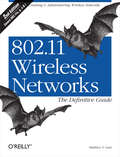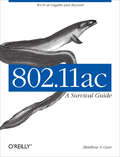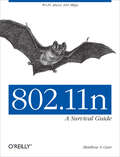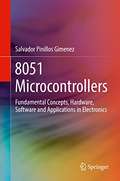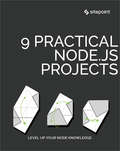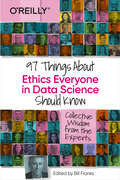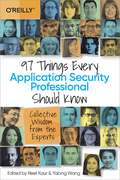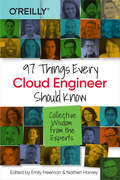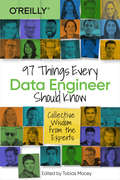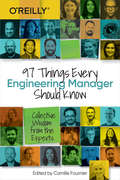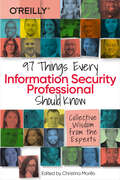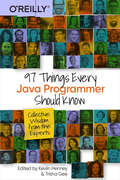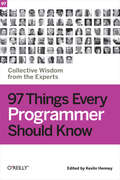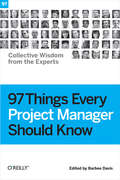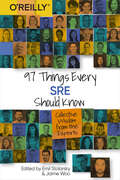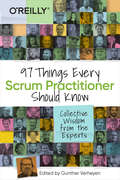- Table View
- List View
8 Steps to Better Security: A Simple Cyber Resilience Guide for Business
by Kim CrawleyHarden your business against internal and external cybersecurity threats with a single accessible resource. In 8 Steps to Better Security: A Simple Cyber Resilience Guide for Business, cybersecurity researcher and writer Kim Crawley delivers a grounded and practical roadmap to cyber resilience in any organization. Offering you the lessons she learned while working for major tech companies like Sophos, AT&T, BlackBerry Cylance, Tripwire, and Venafi, Crawley condenses the essence of business cybersecurity into eight steps. Written to be accessible to non-technical businesspeople as well as security professionals, and with insights from other security industry leaders, this important book will walk you through how to: Foster a strong security culture that extends from the custodial team to the C-suite Build an effective security team, regardless of the size or nature of your business Comply with regulatory requirements, including general data privacy rules and industry-specific legislation Test your cybersecurity, including third-party penetration testing and internal red team specialists Perfect for CISOs, security leaders, non-technical businesspeople, and managers at any level, 8 Steps to Better Security is also a must-have resource for companies of all sizes, and in all industries.
8-Bit Apocalypse: The True Story Behind The Classic Video Game
by Alex Rubens Jeff GerstmannThe first history of Atari’s Missile Command, and its unforeseen effects on its creators and the culture Before Call of Duty, before World of Warcraft, before even Super Mario Bros., the video game industry exploded in the late 1970s with the advent of the video arcade. Leading the charge was Atari Inc., the creator of, among others, the iconic game Missile Command. The first game to double as a commentary on culture, Missile Command put the players’ fingers on “the button,” making them responsible for the fate of civilization in a no-win scenario, all for the price of a quarter. The game was a marvel of modern culture, helping usher in both the age of the video game and the video game lifestyle. Its groundbreaking implications inspired a fanatical culture that persists to this day. As fascinating as the cultural reaction to Missile Command were the programmers behind it. Before the era of massive development teams and worship of figures like Steve Jobs, Atari was manufacturing arcade machines designed, written, and coded by individual designers. As earnings from their games entered the millions, these creators were celebrated as geniuses in their time; once dismissed as nerds and fanatics, they were now being interviewed for major publications, and partied like Wall Street traders. However, the toll on these programmers was high: developers worked 120-hour weeks, often opting to stay in the office for days on end while under a deadline. Missile Command creator David Theurer threw himself particularly fervently into his work, prompting not only declining health and a suffering relationship with his family, but frequent nightmares about nuclear annihilation. To truly tell the story from the inside, tech insider and writer Alex Rubens has interviewed numerous major figures from this time: Nolan Bushnell, founder of Atari; David Theurer, the creator of Missile Command; and Phil Klemmer, writer for the NBC series Chuck, who wrote an entire episode for the show about Missile Command and its mythical “kill screen.” Taking readers back to the days of TaB cola, dot matrix printers, and digging through the couch for just one more quarter, Alex Rubens combines his knowledge of the tech industry and experience as a gaming journalist to conjure the wild silicon frontier of the 8-bit ’80s. 8-Bit Apocalypse: The Untold Story of Atari's Missile Command offers the first in-depth, personal history of an era for which fans have a lot of nostalgia.
80 sposobów na Ajax
by Bruce W. PerryTechniki tworzenia nowoczesnych aplikacji internetowych Przygotowywanie wygodnych w obs?udze formularzy Integracja witryny z Google Maps Zarzšdzanie po?šczeniami sieciowymi Ajax to nazwa technologii powsta?ej w wyniku po?šczenia j?zyka JavaScript, XML oraz kaskadowych arkuszy stylów. Jej wdro?enie pozwala wyeliminowa? ze stron WWW jednš z ich najbardziej irytujšcych cech, czyli konieczno?? prze?adowywania zawarto?ci po ka?dej zmianie. Umiej?tne wykorzystanie mo?liwo?ci Ajaksa sprawia, ?e aplikacje internetowe przypominajš "zwyk?e" programy dla systemów Windows lub Mac OS. Dzi?ki zastosowaniu Ajaksa aplikacja internetowa dzia?a zdecydowanie szybciej, a po?šczenia z serwerem nie przeszkadzajš u?ytkownikowi w pracy. ?atwiejsza jest tak?e dynamiczna zmiana elementów w ró?nych cz??ciach strony. Rozwišzania oparte na Ajaksie wprowadzono w wielu dziedzinach, takich jak blogi, narz?dzia s?u?šce do nauki, newslettery oraz ma?e portale internetowe. W ksiš?ce "80 sposobów na Ajax" znajdziesz przyk?ady zastosowania tej techniki w tworzeniu interesujšcych i nieszablonowych witryn WWW. Czytajšc jš, dowiesz si?, jak sprawi?, aby witryny WWW by?y bardziej interaktywne, a aplikacje WWW dzia?a?y dok?adnie tak jak aplikacje desktopowe. Nauczysz si? korzysta? z interfejsów programistycznych witryn Google Maps, Yahoo! Maps i Geo URL oraz obs?ugiwa? sesje i cookies z poziomu Ajaksa. Poznasz równie? metody weryfikowania poprawno?ci danych wprowadzanych do formularzy oraz techniki ?šczenia Ajaksa z innymi nowoczesnymi narz?dziami, takimi jak Ruby on Rails. Tworzenie interaktywnych formularzy Po?šczenia z Google Maps i Yahoo! Maps Korzystanie z us?ugi Geo URL Obs?uga plików cookies Przeglšdanie kana?ów RSS Integracja z aplikacjami sieciowymi napisanymi w Javie Korzystanie z bibliotek Prototype i Rico Po?šczenie Ajaksa z Ruby on Rails Wykorzystanie biblioteki script.aculo.us do tworzenia efektów wizualnych Twórz szybkie, wydajne i wygodne w obs?udze aplikacje sieciowe.
80/20 Sales and Marketing
by Richard Koch Perry MarshallGuided by famed marketing consultant and best-selling author Perry Marshall, sales and marketing professionals save 80 percent of their time and money by zeroing in on the right 20 percent of their market - then apply 80/202 and 80/203 to gain 10X, even 100X the success. With a powerful 80/20 software tool (online, included with the book), sellers and marketers uncover how to slash time-wasters; advertise to hyper-responsive buyers and avoid tire-kickers; gain coveted positions on search engines; differentiate themselves from competitors and gain esteem in their marketplace. With the included tools they'll see exactly how much money they're leaving on the table, and how to put it back in their pockets. Sellers will identify untapped markets, high-profit opportunities and incremental improvements, gaining time and greater profit potential. Supported by online tools from Marshall, including The 80/20 Power Curve, a tool that helps you see invisible money, and a Marketing DNA Test, a personal assessment that zeroes in on one's natural selling assets, this timeless guide promises to change the game for seasoned and novice marketers and sellers.
802.11 Security
by Bruce Potter Bob FleckBeginning with an introduction to 802.11b in general, 802.11 Security gives you a broad basis in theory and practice of wireless security, dispelling some of the myths along the way. In doing so, they provide you with the technical grounding required to think about how the rest of the book applies to your specific needs and situations. If you are a network, security, or systems engineer, or anyone interested in deploying 802.11b--based systems, you'll want this book beside you every step of the way
802.11 Wireless Networks
by Alan Holt Chi-Yu HuangWireless communication has the advantage of mobility and obviates the need for cabling, but is inherently less secure and is subject to the heavy regulation of the radio frequency spectrum. Nevertheless, the allocation of unlicensed parts of the spectrum has facilitated the growth in wireless local area networks (WLANs). WLAN technology is progressing at a rapid pace, but the most widely accepted WLAN standard is the IEEE 802.11. This unique and highly practical text introduces the principles of WLANs based upon the IEEE 802.11 standards, demonstrating how to configure equipment in order to implement various network solutions. Readers will gain understanding of the security implications of wireless networks and learn how vulnerabilities can be mitigated. Additionally, the book examines the underlying 802.11 protocols and explains how to build mathematical models in order to analyze performance in a WLAN environment. Topics and Features: presents a practical approach supported by the extensive use of examples and detailed instructions; discusses various wireless network solutions across a number of different vendor platforms, including Cisco Aironet, Alactel-Lucent Omniaccess and Meru Networks; provides numerous mathematical models for analyzing the performance of IEEE 802.11 standards, and shows how to build these models using Maple; examines issues of wireless security and describes how to implement a wireless network with enterprise security; investigates the medium access control sub-layer, and models for performance analysis of the MAC layer; reviews the physical sub-layers of 802.11, describing modulation techniques and examining how devices adapt to changes in the RF environment. A highly useful text/reference for industry professionals, undergraduate and graduate-level students will also find this book an ideal companion to a university course on wireless networking. Dr. Alan Holt is Chief Technical Officer at the network consultancy company IP Performance Ltd., based in Bristol, UK. He is author of the popular Springer text Network Performance Analysis: Using the J Programming Language. Dr. Chi-Yu Huang works for Tata Technologies Ltd., and is currently a software consultant on the Airbus project in Bristol. She was formerly Operations Manager for DL Consulting, New Zealand.
802.11 Wireless Networks: The Definitive Guide
by Matthew GastAs we all know by now, wireless networks offer many advantages over fixed (or wired) networks. Foremost on that list is mobility, since going wireless frees you from the tether of an Ethernet cable at a desk. But that's just the tip of the cable-free iceberg. Wireless networks are also more flexible, faster and easier for you to use, and more affordable to deploy and maintain. The de facto standard for wireless networking is the 802.11 protocol, which includes Wi-Fi (the wireless standard known as 802.11b) and its faster cousin, 802.11g. With easy-to-install 802.11 network hardware available everywhere you turn, the choice seems simple, and many people dive into wireless computing with less thought and planning than they'd give to a wired network. But it's wise to be familiar with both the capabilities and risks associated with the 802.11 protocols. And 802.11 Wireless Networks: The Definitive Guide , 2nd Edition is the perfect place to start. This updated edition covers everything you'll ever need to know about wireless technology. Designed with the system administrator or serious home user in mind, it's a no-nonsense guide for setting up 802.11 on Windows and Linux. Among the wide range of topics covered are discussions on: deployment considerations network monitoring and performance tuning wireless security issues how to use and select access points network monitoring essentials wireless card configuration security issues unique to wireless networks With wireless technology, the advantages to its users are indeed plentiful. Companies no longer have to deal with the hassle and expense of wiring buildings, and households with several computers can avoid fights over who's online. And now, with 802.11 Wireless Networks: The Definitive Guide , 2nd Edition, you can integrate wireless technology into your current infrastructure with the utmost confidence.
802.11 Wireless Networks: The Definitive Guide
by Matthew S. GastAs we all know by now, wireless networks offer many advantages over fixed (or wired) networks. Foremost on that list is mobility, since going wireless frees you from the tether of an Ethernet cable at a desk. But that's just the tip of the cable-free iceberg. Wireless networks are also more flexible, faster and easier for you to use, and more affordable to deploy and maintain.The de facto standard for wireless networking is the 802.11 protocol, which includes Wi-Fi (the wireless standard known as 802.11b) and its faster cousin, 802.11g. With easy-to-install 802.11 network hardware available everywhere you turn, the choice seems simple, and many people dive into wireless computing with less thought and planning than they'd give to a wired network. But it's wise to be familiar with both the capabilities and risks associated with the 802.11 protocols. And 802.11 Wireless Networks: The Definitive Guide, 2nd Edition is the perfect place to start.This updated edition covers everything you'll ever need to know about wireless technology. Designed with the system administrator or serious home user in mind, it's a no-nonsense guide for setting up 802.11 on Windows and Linux. Among the wide range of topics covered are discussions on:deployment considerationsnetwork monitoring and performance tuningwireless security issueshow to use and select access pointsnetwork monitoring essentialswireless card configurationsecurity issues unique to wireless networksWith wireless technology, the advantages to its users are indeed plentiful. Companies no longer have to deal with the hassle and expense of wiring buildings, and households with several computers can avoid fights over who's online. And now, with 802.11 Wireless Networks: The Definitive Guide, 2nd Edition, you can integrate wireless technology into your current infrastructure with the utmost confidence.
802.11ac: Wi-Fi at Gigabit and Beyond
by Matthew S. GastThe next frontier for wireless LANs is 802.11ac, a standard that increases throughput beyond one gigabit per second. This concise guide provides in-depth information to help you plan for 802.11ac, with technical details on design, network operations, deployment, and monitoring.Author Matthew Gast—an industry expert who led the development of 802.11-2012 and security task groups at the Wi-Fi Alliance—explains how 802.11ac will not only increase the speed of your network, but its capacity as well. Whether you need to serve more clients with your current level of throughput, or serve your existing client load with higher throughput, 802.11ac is the solution. This book gets you started.Understand how the 802.11ac protocol works to improve the speed and capacity of a wireless LANExplore how beamforming increases speed capacity by improving link margin, and lays the foundation for multi-user MIMOLearn how multi-user MIMO increases capacity by enabling an AP to send data to multiple clients simultaneouslyPlan when and how to upgrade your network to 802.11ac by evaluating client devices, applications, and network connections
802.11n: Wi-Fi Above 100 Mbps
by Matthew S. GastWireless has finally come of age. With a significant jump in throughput over previous standards, 802.11n is the first wireless technology that doesn’t trade speed for mobility, and users have stormed onto wireless networks with a passion. In this concise guide, Matthew Gast—chair of the IEEE group that produced revision 802.11-2012—shows you why wireless has become the default method of connecting to a network, and provides technical details you need to plan, design, and deploy 802.11n today.Building a network for the multitude of new devices is now a strategic decision for network engineers everywhere. This book gives you an in-depth look at key parts of 802.11n, and shows you how to achieve an Ethernet-free wireless office.Learn how MIMO’s multiple data streams greatly increase wireless speedDiscover how 802.11n modifications improve MAC efficiencyExamine advanced PHY features such as beanforming and space-time code blockUse advanced MAC features to maintain interoperability with older devicesPlan an 802.11n network by determining traffic demand, key applications, power requirements, and securityChoose the architecture, select hardware, and plan coverage to design and build your network
8051 Microcontrollers: Fundamental Concepts, Hardware, Software And Applications In Electronics
by Salvador Pinillos GimenezExplains internals of 8051 hardware and relates to general principles of computer architecture;<P><P> Demonstrates how to implement various electronics applications, with hardware and software design for 8051 microcontrollers;<P> Includes numerous, solved examples, end-of-chapter exercises, laboratory and practical projects.<P>This textbook describes in detail the fundamental information about the 8051 microcontroller and it carefully teaches readers how to use the microcontroller to make both electronics hardware and software. In addition to discussion of the 8051 internals, this text includes numerous, solved examples, end-of-chapter exercises, laboratory and practical projects.
8th International Conference on Advancements of Medicine and Health Care Through Technology: Proceedings of MEDITECH 2022, October 20–22, 2022, Cluj-Napoca, Romania (IFMBE Proceedings #102)
by Simona Vlad Nicolae Marius RomanThis book gathers the proceedings of the 8th International Conference on Advancements of Medicine and Health Care through Technology, MEDITECH 2022, held virtually on 20–22 October 2022, from Cluj-Napoca, Romania. It reports on both theoretical and practical developments in biomedical imaging and image processing, health technology, technologies for education, and biomedical signal processing and medical devices, measurements and instrumentation. Both the conference and the realization of this book were supported by the Romanian National Society for Medical Engineering and Biological Technology (SNIMTB).
9 Practical Node.js Projects
by Simon Holmes Michael Wanyoike James Kolce Jeremy Wilken James Hibbard Lukas White Paul Orac Patrick CatanzaritiWhile there have been quite a few attempts to get JavaScript working as a server-side language, Node.js (frequently just called Node) has been the first environment that's gained any traction. It's now used by companies such as Netflix, Uber and Paypal to power their web apps. Node allows for blazingly fast performance; thanks to its event loop model, common tasks like network connection and database I/O can be executed very quickly indeed. In this book, we offer a selection of nine different practical projects that you can follow along with. It contains: Build a Simple Beginner App with Node, Bootstrap & MongoDB by James HibbardHow to Build a File Upload Form with Express and Dropzone.js by Lukas WhiteHow to Build and Structure a Node.js MVC Application by James KolceUser Authentication with the MEAN Stack by Simon Holmes & Jeremy WilkenBuild a JavaScript Command Line Interface (CLI) with Node.js by Lukas White & Michael WanyoikeBuilding a Real-time Chat App with Sails.js by Michael WanyoikePassport Authentication for Node.js Applications by Paul OracLocal Authentication Using Passport in Node.js by Paul OracAn Introduction to NodeBots by Patrick Catanzariti This book is for anyone who wants to start learning server-side development with Node.js. Familiarity with JavaScript is assumed.
96 Common Challenges in Power Query: Practical Solutions for Mastering Data Transformation in Excel and Power BI
by Omid MotamedisedehThis comprehensive guide is designed to address the most frequent and challenging issues faced by users of Power Query, a powerful data transformation tool integrated into Excel, Power BI, and Microsoft Azure. By tackling 96 real-world problems with practical, step-by-step solutions, this book is an essential resource for data analysts, Excel enthusiasts, and Power BI professionals. It aims to enhance your data transformation skills and improve efficiency in handling complex data sets. Structured into 12 chapters, the book covers specific areas of Power Query such as data extraction, referencing, column splitting and merging, sorting and filtering, and pivoting and unpivoting tables. You will learn to combine data from Excel files with varying column names, handle multi-row headers, perform advanced filtering, and manage missing values using techniques such as linear interpolation and K-nearest neighbors (K-NN) imputation. The book also dives into advanced Power Query functions such as Table.Group, List.Accumulate, and List.Generate, explored through practical examples such as calculating running totals and implementing complex grouping and iterative processes. Additionally, it covers crucial topics such as error-handling strategies, custom function creation, and the integration of Python and R with Power Query. In addition to providing explanations on the use of functions and the M language for solving real-world challenges, this book discusses optimization techniques for data cleaning processes and improving computational speed. It also compares the execution time of functions across different patterns and proposes the optimal approach based on these comparisons. In today’s data-driven world, mastering Power Query is crucial for accurate and efficient data processing. But as data complexity grows, so do the challenges and pitfalls that users face. This book serves as your guide through the noise and your key to unlocking the full potential of Power Query. You’ll quickly learn to navigate and resolve common issues, enabling you to transform raw data into actionable insights with confidence and precision. What You Will Learn Master data extraction and transformation techniques for various Excel file structures Apply advanced filtering, sorting, and grouping methods to organize and analyze data Leverage powerful functions such as Table.Group, List.Accumulate, and List.Generate for complex transformations Optimize queries to execute faster Create and utilize custom functions to handle iterative processes and advanced list transformation Implement effective error-handling strategies, including removing erroneous rows and extracting error reasons Customize Power Query solutions to meet specific business needs and share custom functions across files Who This Book Is For Aspiring and developing data professionals using Power Query in Excel or Power BI who seek practical solutions to enhance their skills and streamline complex data transformation workflows
97 Things About Ethics Everyone in Data Science Should Know: Collective Wisdom From The Experts
by Bill FranksMost of the high-profile cases of real or perceived unethical activity in data science arenâ??t matters of bad intent. Rather, they occur because the ethics simply arenâ??t thought through well enough. Being ethical takes constant diligence, and in many situations identifying the right choice can be difficult.In this in-depth book, contributors from top companies in technology, finance, and other industries share experiences and lessons learned from collecting, managing, and analyzing data ethically. Data science professionals, managers, and tech leaders will gain a better understanding of ethics through powerful, real-world best practices.Articles include:Ethics Is Not a Binary Conceptâ??Tim WilsonHow to Approach Ethical Transparencyâ??Rado KotorovUnbiased ≠ Fairâ??Doug HagueRules and Rationalityâ??Christof Wolf BrennerThe Truth About AI Biasâ??Cassie KozyrkovCautionary Ethics Talesâ??Sherrill HayesFairness in the Age of Algorithmsâ??Anna JacobsonThe Ethical Data Storytellerâ??Brent DykesIntroducing Ethicizeâ?¢, the Fully AI-Driven Cloud-Based Ethics Solution!â??Brian Oâ??NeillBe Careful with "Decisions of the Heart"â??Hugh WatsonUnderstanding Passive Versus Proactive Ethicsâ??Bill Schmarzo
97 Things Every Application Security Professional Should Know
by Reet Kaur Yabing WangAs technology continues to advance and more business is conducted online, the potential attack surface increases exponentially and the need for strong application security measures become more and more crucial. This goes double for any organization that handles sensitive personal or financial information which is usually subject to government regulation. The consequences of a successful attack at the application level can be devastating for an organization, ranging from loss of revenue, to damaged reputation, to potential fines and other penalties.This book also introduces you to:What's considered application security and what security professionals should knowWhat developers or software engineers should know about common application vulnerabilities How to design, develop, and test applications so that the application or software is able to defend against exploits and attacksWays to provide readers with fresh perspectives, various insights, and many practical ways to address cyber security related to application developmentThis advice can be applied in development for web, mobile, APIs or other software development, in different development languages, in waterfall and agile software development lifecycle (SDLC), and in the cloud.
97 Things Every Cloud Engineer Should Know: Collective Wisdom From The Experts
by Emily Freeman Nathen HarveyIf you create, manage, operate, or configure systems running in the cloud, you're a cloud engineer--even if you work as a system administrator, software developer, data scientist, or site reliability engineer. With this book, professionals from around the world provide valuable insight into today's cloud engineering role.These concise articles explore the entire cloud computing experience, including fundamentals, architecture, and migration. You'll delve into security and compliance, operations and reliability, and software development. And examine networking, organizational culture, and more. You're sure to find 1, 2, or 97 things that inspire you to dig deeper and expand your own career."Three Keys to Making the Right Multicloud Decisions," Brendan O'Leary"Serverless Bad Practices," Manases Jesus Galindo Bello"Failing a Cloud Migration," Lee Atchison"Treat Your Cloud Environment as If It Were On Premises," Iyana Garry"What Is Toil, and Why Are SREs Obsessed with It?", Zachary Nickens"Lean QA: The QA Evolving in the DevOps World," Theresa Neate"How Economies of Scale Work in the Cloud," Jon Moore"The Cloud Is Not About the Cloud," Ken Corless"Data Gravity: The Importance of Data Management in the Cloud," Geoff Hughes"Even in the Cloud, the Network Is the Foundation," David Murray"Cloud Engineering Is About Culture, Not Containers," Holly Cummins
97 Things Every Data Engineer Should Know
by Tobias MaceyTake advantage of today's sky-high demand for data engineers. With this in-depth book, current and aspiring engineers will learn powerful real-world best practices for managing data big and small. Contributors from notable companies including Twitter, Google, Stitch Fix, Microsoft, Capital One, and LinkedIn share their experiences and lessons learned for overcoming a variety of specific and often nagging challenges.Edited by Tobias Macey, host of the popular Data Engineering Podcast, this book presents 97 concise and useful tips for cleaning, prepping, wrangling, storing, processing, and ingesting data. Data engineers, data architects, data team managers, data scientists, machine learning engineers, and software engineers will greatly benefit from the wisdom and experience of their peers.Topics include:The Importance of Data Lineage - Julien Le DemData Security for Data Engineers - Katharine JarmulThe Two Types of Data Engineering and Data Engineers - Jesse AndersonSix Dimensions for Picking an Analytical Data Warehouse - Gleb MezhanskiyThe End of ETL as We Know It - Paul SingmanBuilding a Career as a Data Engineer - Vijay KiranModern Metadata for the Modern Data Stack - Prukalpa SankarYour Data Tests Failed! Now What? - Sam Bail
97 Things Every Engineering Manager Should Know: Collective Wisdom from the Experts
by Camille FournierTap into the wisdom of experts to learn what every engineering manager should know. With 97 short and extremely useful tips for engineering managers, you'll discover new approaches to old problems, pick up road-tested best practices, and hone your management skills through sound advice.Managing people is hard, and the industry as a whole is bad at it. Many managers lack the experience, training, tools, texts, and frameworks to do it well. From mentoring interns to working in senior management, this book will take you through the stages of management and provide actionable advice on how to approach the obstacles you’ll encounter as a technical manager.A few of the 97 things you should know:"Three Ways to Be the Manager Your Report Needs" by Duretti Hirpa"The First Two Questions to Ask When Your Team Is Struggling" by Cate Huston"Fire Them!" by Mike Fisher"The 5 Whys of Organizational Design" by Kellan Elliott-McCrea"Career Conversations" by Raquel Vélez"Using 6-Page Documents to Close Decisions" by Ian Nowland"Ground Rules in Meetings" by Lara Hogan
97 Things Every Information Security Professional Should Know: Collective Wisdom from the Experts
by Christina MorilloWhether you're searching for new or additional opportunities, information security can be vast and overwhelming. In this practical guide, author Christina Morillo introduces technical knowledge from a diverse range of experts in the infosec field. Through 97 concise and useful tips, you'll learn how to expand your skills and solve common issues by working through everyday security problems.You'll also receive valuable guidance from professionals on how to navigate your career within this industry. How do you get buy-in from the C-suite for your security program? How do you establish an incident and disaster response plan? This practical book takes you through actionable advice on a wide variety of infosec topics, including thought-provoking questions that drive the direction of the field.Continuously Learn to Protect Tomorrow's Technology - Alyssa ColumbusFight in Cyber Like the Military Fights in the Physical - Andrew HarrisKeep People at the Center of Your Work - Camille StewartInfosec Professionals Need to Know Operational Resilience - Ann JohnsonTaking Control of Your Own Journey - Antoine MiddletonSecurity, Privacy, and Messy Data Webs: Taking Back Control in Third-Party Environments - Ben BrookEvery Information Security Problem Boils Down to One Thing - Ben SmithFocus on the WHAT and the Why First, Not the Tool - Christina Morillo
97 Things Every Java Programmer Should Know: Collective Wisdom from the Experts
by Kevlin Henney Trisha GeeIf you want to push your Java skills to the next level, this book provides expert advice from Java leaders and practitioners. You’ll be encouraged to look at problems in new ways, take broader responsibility for your work, stretch yourself by learning new techniques, and become as good at the entire craft of development as you possibly can.Edited by Kevlin Henney and Trisha Gee, 97 Things Every Java Programmer Should Know reflects lifetimes of experience writing Java software and living with the process of software development. Great programmers share their collected wisdom to help you rethink Java practices, whether working with legacy code or incorporating changes since Java 8.A few of the 97 things you should know:"Behavior Is Easy, State Is Hard"—Edson Yanaga“Learn Java Idioms and Cache in Your Brain”—Jeanne Boyarsky“Java Programming from a JVM Performance Perspective”—Monica Beckwith"Garbage Collection Is Your Friend"—Holly K Cummins“Java's Unspeakable Types”—Ben Evans"The Rebirth of Java"—Sander Mak“Do You Know What Time It Is?”—Christin Gorman
97 Things Every Programmer Should Know: Collective Wisdom from the Experts
by Kevlin HenneyTap into the wisdom of experts to learn what every programmer should know, no matter what language you use. With the 97 short and extremely useful tips for programmers in this book, you'll expand your skills by adopting new approaches to old problems, learning appropriate best practices, and honing your craft through sound advice.With contributions from some of the most experienced and respected practitioners in the industry--including Michael Feathers, Pete Goodliffe, Diomidis Spinellis, Cay Horstmann, Verity Stob, and many more--this book contains practical knowledge and principles that you can apply to all kinds of projects.A few of the 97 things you should know:"Code in the Language of the Domain" by Dan North"Write Tests for People" by Gerard Meszaros"Convenience Is Not an -ility" by Gregor Hohpe"Know Your IDE" by Heinz Kabutz"A Message to the Future" by Linda Rising"The Boy Scout Rule" by Robert C. Martin (Uncle Bob)"Beware the Share" by Udi Dahan
97 Things Every Project Manager Should Know: Collective Wisdom from the Experts
by Barbee DavisIf the projects you manage don't go as smoothly as you'd like, 97 Things Every Project Manager Should Know offers knowledge that's priceless, gained through years of trial and error. This illuminating book contains 97 short and extremely practical tips -- whether you're dealing with software or non-IT projects -- from some of the world's most experienced project managers and software developers. You'll learn how these professionals have dealt with everything from managing teams to handling project stakeholders to runaway meetings and more. While this book highlights software projects, its wise axioms contain project management principles applicable to projects of all types in any industry. You can read the book end to end or browse to find topics that are of particular relevance to you. 97 Things Every Project Manager Should Know is both a useful reference and a source of inspiration.Among the 97 practical tips:"Clever Code Is Hard to Maintain...and Maintenance Is Everything" -- David Wood, Partner, Zepheira"Every Project Manager Is a Contract Administrator" -- Fabio Teixeira de Melo, Planning Manager, Construtora Norberto Odebrecht"Can Earned Value and Velocity Coexist on Reports?" -- Barbee Davis, President, Davis Consulting"How Do You Define 'Finished'"? -- Brian Sam-Bodden, author, software architect"The Best People to Create the Estimates Are the Ones Who Do the Work" -- Joe Zenevitch, Senior Project Manager, ThoughtWorks"How to Spot a Good IT Developer" -- James Graham, independent management consultant"One Deliverable, One Person" -- Alan Greenblatt, CEO, Sciova
97 Things Every SRE Should Know: Collective Wisdom From The Experts
by Emil Stolarsky Jaime WooSite reliability engineering (SRE) is more relevant than ever. Knowing how to keep systems reliable has become a critical skill. With this practical book, newcomers and old hats alike will explore a broad range of conversations happening in SRE. You'll get actionable advice on several topics, including how to adopt SRE, why SLOs matter, when you need to upgrade your incident response, and how monitoring and observability differ.Editors Jaime Woo and Emil Stolarsky, co-founders of Incident Labs, have collected 97 concise and useful tips from across the industry, including trusted best practices and new approaches to knotty problems. You'll grow and refine your SRE skills through sound advice and thought-provokingquestions that drive the direction of the field.Some of the 97 things you should know:"Test Your Disaster Plan"--Tanya Reilly"Integrating Empathy into SRE Tools"--Daniella Niyonkuru"The Best Advice I Can Give to Teams"--Nicole Forsgren"Where to SRE"--Fatema Boxwala"Facing That First Page"--Andrew Louis"I Have an Error Budget, Now What?"--Alex Hidalgo"Get Your Work Recognized: Write a Brag Document"--Julia Evans and Karla Burnett
97 Things Every Scrum Practitioner Should Know: Collective Wisdom from the Experts
by Gunther VerheyenImprove your understanding of Scrum through the proven experience and collected wisdom of experts around the world. Based on real-life experiences, the 97 essays in this unique book provide a wealth of knowledge and expertise from established practitioners who have dealt with specific problems and challenges with Scrum.You'll find out more about the rules and roles of this framework, as well as tactics, strategies, specific patterns to use with Scrum, and stories from the trenches. You'll also gain insights on how to apply, tune, and tweak Scrum for your work. This guide is an ideal resource for people new to Scrum and those who want to assess and improve their understanding of this framework."Scrum Is Simple. Just Use It As Is.," Ken Schwaber"The 'Standing Meeting,'" Bob Warfield"Specialization Is for Insects," James O. Coplien"Scrum Events Are Rituals to Ensure Good Harvest," Jasper Lamers"Servant Leadership Starts from Within," Bob Galen"Agile Is More than Sprinting," James W. Grenning
